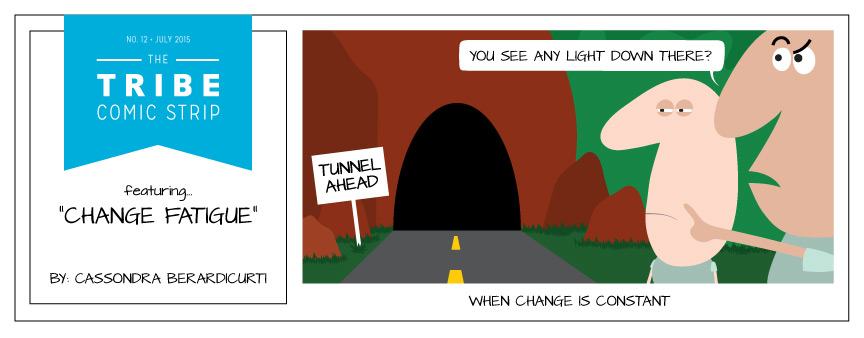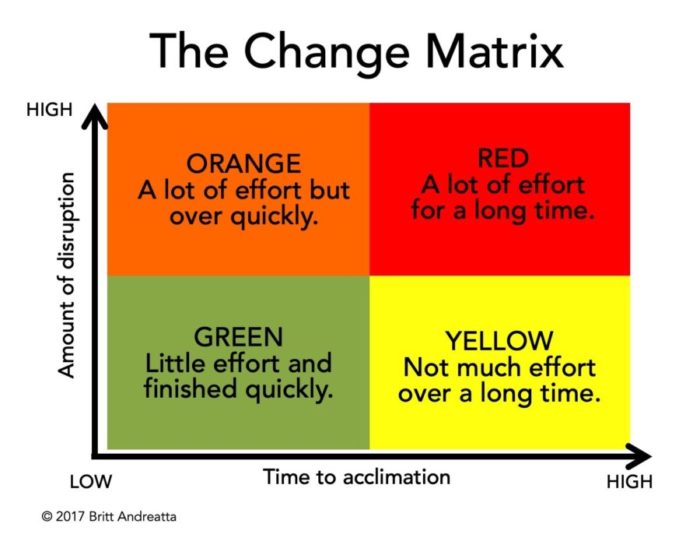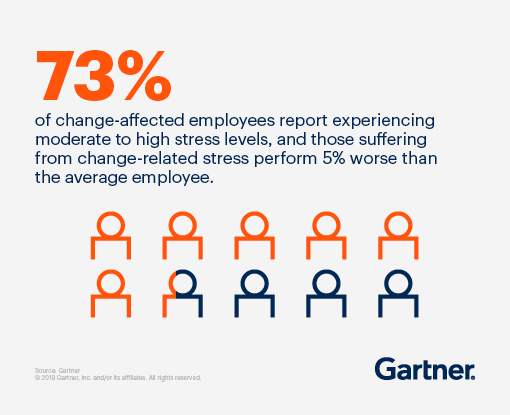Change is good, right? You must change to grow as it brings new ideas and possibilities to your organization and personal life. In fact, change, whether it be tectonic in size or less conspicuous, is a part of every active business. It is when there is too much of it over a prolonged period that it can result in arduous and weary outcomes for leaders and their team members. Although we begin with COVID-related change-fatigue, simply for some grounding, we do not end there. We will equip you as leaders and busy executives with helpful leadership tactics to get you through 2021 and beyond.
Understanding what change-fatigue is
Change-fatigue can have a big impact on both your organization’s ability to expand, grow, and evolve, as well as its more common impacts on an organization’s daily operations. Change-fatigue should not be confused or mistaken for being resistant to change. That is not what we are addressing here. What we are addressing is change-fatigue, which often occurs when an onslaught of change (ie: the entire year of 2020) occurs, when organizational leadership, employees-at-large, teams, and, at times, customers, are asked to constantly evolve with a brand or company to the point that exhaustion becomes the overarching experience (as opposed to maintaining change-focused resiliency, which is often the mindset that employees begin with).
Here is an image that displays how some employees coped with COVID-related changes from last year.
The year 2020 aside, the need to be constantly changing (we can also include references of “constant improvement” here, which is commonly utilized language for “ongoing” micro-based corporate change) is a compounding pressure that every company has in the business world today. This call to adapt, or change, is even bemoaned by the titans of industry, such as Jack Welch, warning, “If the change on the outside exceeds the change on the inside, the end is near.” Welch warns, more or less, that if the environment or your industry’s rate of change exceeds the internal changes within your organization, you’re doomed.
As we dive further into what change-fatigue is and how it can impact an organization, we have to first review some labels so we can identify change-fatigue when we as leaders see it. Otherwise, what we see when we look at our employees is, tired, unmotivated, disorganized, lazy, unconcerned, and/or careless behaviors within the workplace (when really, it is none of those — what you are seeing is remorseless and unrelenting change-fatigue).
Seven leadership hacks to actively engage your (fatigued) employees
The first thing that we should all remind ourselves of is that not all change-fatigue can be avoided (think 2020). No one decided to launch the COVID-19 pandemic — it just happened. When change is out of our hands, we need to be ready to interact with employees and customers alike to ensure that the organizational corpus moves or evolves as one.
For example, a company’s ability to effectively communicate may be the only thing it has control over when it is the environment, economy, or a lasting social movement that is impacting or forcing the organizational change.
Remember, this is a work-life hack list that can help you manage (and, hopefully, reduce) change-induced fatigue, not to illuminate change itself (as that is a part of any living business).
1. Communicate. Communicate. Communicate.
Yes, we are getting the obvious one out of the way first. A lot of what is behind change fatigue within teams is the constant state of “not knowing” what is next, or what the final outcome will be, or whether or not their job (and thus their family) is safe.
You may be surprised how often we see leadership teams mess this up. Even if employers have nothing else to say other than “…we don’t know what will happen next, but we are in this together…” that alone can be helpful. There is knowledge and togetherness in that message.
2. Be completely, even brutally, honest and do not overpromise
This is second on our list because it is just as important as company-wide communication. We see too many companies hold back the full picture from their employees to “save them the pain and heartache of knowing” what is about to occur. This almost always backfires. If you know that there will be a reduction in force (RIF), or mass layoffs, reduced sales expectations for the next two quarters, a merger or acquisition, etc., share the news as soon as you know it to be certain.
Note: Ensure that you have a thoughtful communication plan that all senior leadership team members are dialed in on prior to releasing critical, company-wide information. For large, complex, uncertain, and/or scary changes, solid communication plans should always consider how employees can privately ask follow-up questions, how to access EAP resources, dates of important events occurring within the given sphere of change, and when subsequent updates will be shared.
3. Prioritize strategic change initiatives
The world of business is dynamic and ever-changing. At times, fiscal years and their strategic plans need to evolve in order to remain solvent (or simply to keep the company alive). Savvy companies double-back to reconsider their strategic initiatives for the year when needed. When the economy (or a social and health care-related global pandemic) throws curve balls at companies, the smart ones adjust course and recalibrate their goals and expectations accordingly.
4. Revisit and share (with everyone) the road map for strategy execution
Letting everyone in on the fact that the company’s strategic plans are changing is one thing, but allowing them to see the picture or plan for how they are going to get from point A to point B is better (this further ties into effective communication). The more employees understand the overall goals at the atmospheric level and how they are going to achieve them, the better the chance that a sense of calm, confidence, and understanding can tapper the anxiety and stress of the day.
5. Outline and explain industry-related (or big picture) cause-and-effects
Do not undersell your employees, nor assume that your average employee does not want to hear about industry trends, how competitors are performing, how suppliers and third-party relationships are coping, etc., in relation to environmental challenges.
Too many times the C-suite only passes down the minimal amount of data to feel as though they have “informed” their teams. That is a recipe for failure moving forward. C-suite leaders need to get used to the fact that more (meaningful) information sharing will be required to keep employees truly engaged, motivated, and passionate for the collective cause.
6. Continue to actively cultivate organizational culture
During times of crisis or, more simply, when a company is just hanging on for dear life, company culture gets thrown in the backseat (or shoved in the trunk). Although tough to do, continue the discipline of placing special and deliberate emphasis on your company’s culture.
Remember that your corporate culture is akin to the communicative dialect and emotional currency employees use to feel as though that they are a part of something important and larger than themselves. When we stop feeding that skeletal framework, the company’s corpus begins fail. Although it may take a while for the fragments to show themselves, we know that it requires twice the effort to build back a meaningful cultural identity than it does to maintain one (even through tough times).
7. Be vulnerable
We saved this one for last as more people will scoff out loud at this suggestion than the others. We are serious though; this is probably one of the more strategic related approaches leadership can take with their employees (as well as other stakeholders). When senior leadership is honest, straightforward, and, yes, vulnerable, it pays huge dividends.
What do we mean by, “be vulnerable?” Good question. When C-suite leadership, including the CEO, is willing and able to share their own frustrations, concerns, and other feelings related to the unknown (again, think of 2020), employees are comforted by the openness and the humanness that their leader is sharing. It humanizes the experience of change-fatigue to know that your leaders, too, are fatigued. This messaging works best when it is shared with positive energy, future-focused terminology, and a commitment to stick together as one while change continues to unfold.
Common examples of change in the workplace
Some of the most common, large-order examples of change within the workplace can include the following (although this is far from a comprehensive list):
• As mentioned, large environmental or societal changes, such as COVID-19 and accompanying events which unfolded during 2020.
• A merger or acquisition (M&A) with another company or companies (which also often includes leadership changes).
• Customer-related growth for (meaning higher demands of) the business.
• Budget restrictions, reduction in force (RIF), or general downsizing-related events.
• Large process or procedural changes within a company.
• Large I.T. related changes such as an enterprise resource planning (ERP) upgrade, change, or improvements.
• Newly appointed senior leadership, which often changes the direction or the method of working within a company.
• New or large product launches.
• Growth into the international scene (beginning business expansion in any new country has unique and, at times, long-lasting growing pains).
Although change, of all kinds, is critical, as it often helps promote organizational growth and sustainability, as well as keeping up with the evolution within one’s industry, it also helps an organization prepare for the unknown. Although some change is company-induced, not all of it is. At times, newly passed government regulations or limitations can impact a business significantly. Merging or acquiring (M&A) another company can dramatically impact normalcy.
The Change Matrix
One model that we feel makes a lot of sense and we believe has helped many leaders visualize how workplace change-fatigue works, is to consider the model that Britt Andreatta created. Andreatta is a workplace consultant and author. This model offers a strong and simple way to anticipate how companies and employees will react to the given change-management realities that you as a leader are asking them to tolerate.
Finally, we all know how the economy can impact any industry’s health. A company may be forced to reduce staff or change product distribution, services offered, and so on. At times, many of these examples land at once, one after the other, after the other. This is how employees within a company arrive at change-fatigue. It is very real and very damaging to the employee and the company. Fully grasping Andreatta’s graph above helps leaders to identify what is around the corner given the change landscape they are embracing.
Common signs of change-fatigue in employees
Although we can argue that there are more than seven, the most revealed symptoms of change-fatigue are listed here:
• Increased absenteeism and/or tardiness: Employees often call in sick or no-show for work. This can be several multi-day call-ins or spotty, one-day-here, one-day-there type occurrences.
• Burn out: After hanging on for as long as they can, employees eventually burn out. It is not uncommon for employees experiencing burn out to come to almost a full stop concerning productivity and timely work production.
• Consistent signs of stress and/or anxiety: Constant change can cause anxiety in employees. Stress is also a resulting effect of change. Whether there are workplace-related outside factors and/or internal factors at play, assume that some degree of employee anxiety and/or stress, is change-related (and not simply caused by “home life”-related issues).
• Social disengagement or withdrawal: Whether it be in the form of apathy, lack of interest or passion, or other forms of withdrawal, disengagement is a common sign of burn out in the workplace.
• Inability to timely complete tasks/projects: Loss of motivation can lead to incomplete, late, and/or poor-quality projects throughout the organization.
• Complaining increases: Although we use the word “complaining” to describe employee disenchantment, one could also mention increased employee arguments, back-biting, gossip, silo-induced behaviors, etc.
• Confusion and forgetfulness: A common sign of stress, anxiety, or fatigue, confusion and/or forgetfulness can result in employees who find it challenging to know what to focus on and plan for, or what to expect next.
The Impact of Change-Fatigue on Your Business
The financial and overall business impacts that change-related fatigue can have on a company is not difficult to imagine. Why is change-fatigue so damaging to businesses today? Simply put, as we have touched on, change-fatigue describes the state that people are in when they have neither the will nor the energy to professionally sustain the current state — nor the will or energy to move through a change process, be it large or small.
The fact is, change fatigue directly impacts productivity, and, if allowed to linger long enough, change fatigue can alter work patterns of employees and teams, resulting in lower expectations for excellence as well as overall output. Some of the more costly outcomes of change-fatigue, or fatigue of any kind within the workplace, include:
• Reduced productivity
When productivity is reduced, product or services are also reduced over time. This can lead to a shortage in physical inventory, to increased labor costs (throwing more energy at pre-established goals or targets), increased follow up with customers due to lackluster service, etc.
• Lower quality of customer service
This can, and often does, result in the loss of customers. If left lingering long enough, this can also lead to an unintentional altering of brand perception within the industry.
• Compounded employee attrition
Over time, employees will eventually break. When that happens, they leave the organization for a new start. This repeated cataclysm slows progress and growth, at an increased expense, and builds upon itself. That is, every employee who leaves your company due to change-related fatigue, significantly increases another leaving, and so on.
• Increased error rates
When employees are fatigued, for any reason, error rates increase, which means quality decreases.
• Increased workplace injuries
Again, one surefire sign of fatigue is when injuries within the workplace increase. This occurs when processes change, personnel within teams or departments shift, workloads increase, etc.
• Fueled employee disengagement and lack of motivation
As we have previously touched on, the corrosive effect on employee engagement and motivation can result in all the aforementioned.
• Eroded workplace culture
Over time, company culture erodes when a large number of team members continue to be saddled with the crippling weight of change fatigue. Since change fatigue-related symptoms are extremely easy to see in others, they are epizootically contagious.
Bottom line
Change fatigue is a part of life, and indelibly a part of the world of commerce. Although leaders often have minimal control over the body-change itself, we do have control over how we receive it, manage it, and communicate through it.
These are not insignificant factors; we can alter the landscape to our advantage when we take what’s coming at us and involve our employees in the strategy for coping, combating, and surviving (or thriving, in some cases) the steep peaks of change that we are at times asked to climb. Reducing change fatigue as much as possible will help save your company time, energy, resources, and (most of all) your team from fraying during tough times.
Photo Credits: SACAP; Tribe (Image by Cassondra Berardicurti); Britt Andreatta; and Gartner










